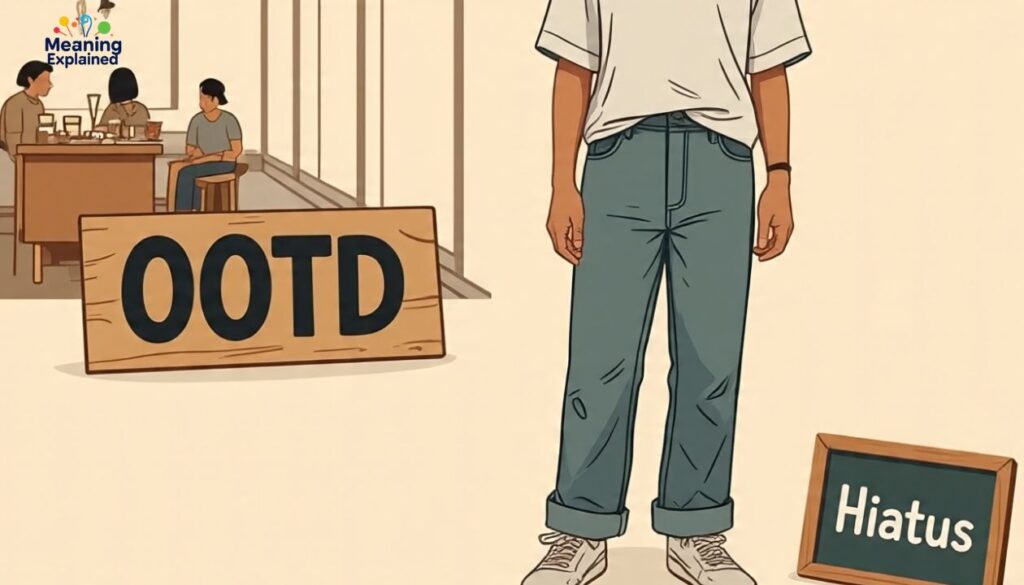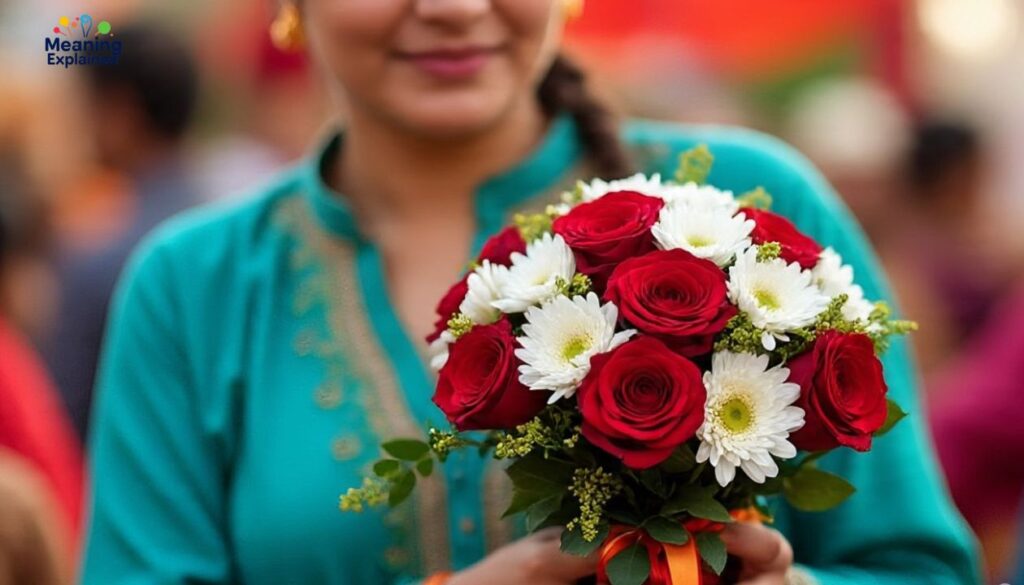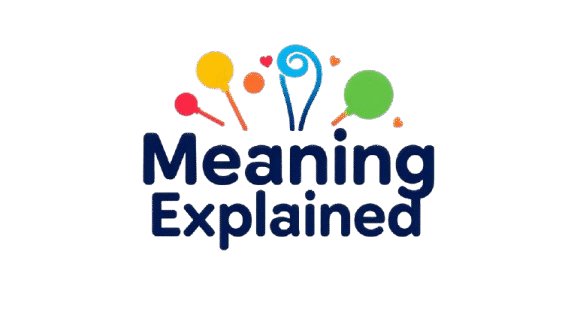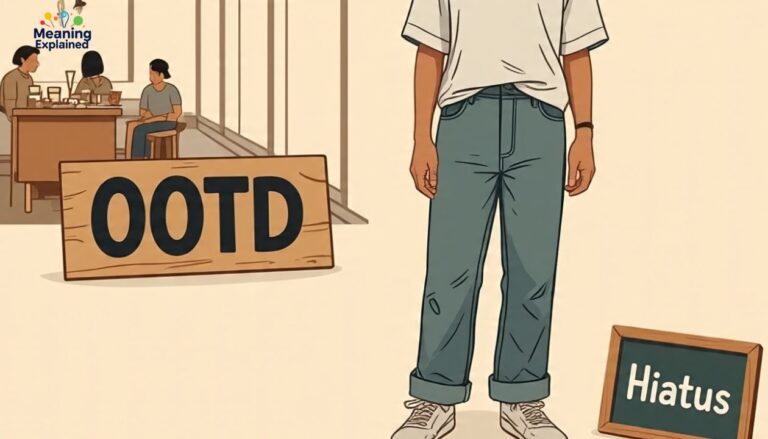In today’s world, abbreviations like OOTD and hiatus are common in texts and social media. These terms can confuse people who aren’t familiar with them. This guide explains what OOTD, hiatus, and “stand for” mean in simple terms.
OOTD and hiatus are used in different situations. OOTD is popular among fashion lovers online, while hiatus often appears in work or entertainment contexts. Knowing these terms helps you understand conversations better.
We’ll also cover how to use these terms correctly and share tips on expressing well wishes. Whether you’re texting friends or writing a professional email, this article will make communication easier and clearer.
What Does OOTD Mean?
Defining OOTD
OOTD stands for “Outfit Of The Day.” It’s a trendy term used on platforms like Instagram, TikTok, and Twitter. People share photos or videos of their daily outfits, showcasing style and personality.
For example:
- “Loving my #OOTD with this cozy sweater!”
- “My OOTD is all about bold colors today.”
OOTD is a staple in fashion circles and among influencers.
The Importance of OOTD in Text and Social Media
OOTD boosts engagement with hashtags, connecting users to fashion communities. It’s versatile—casual in chats with friends or polished in fashion blogs. It reflects mood, trends, or even confidence, making it a fun way to express yourself online.
What Does Hiatus Mean?
Understanding Hiatus
Hiatus is a noun meaning a temporary break or pause in an activity. It’s used for interruptions in work, creative projects, or events.
For example:
- “The podcast is on hiatus until next month.”
- “She took a hiatus from social media.”
It implies a pause, not a permanent stop.
Nuances of Hiatus in Different Contexts
Hiatus sounds more formal than “break” or “pause.” It’s ideal for professional or academic settings, like describing a work sabbatical or a TV show’s seasonal break. It conveys thoughtfulness and precision in communication.
Stand For And Meaning in Text
“Stand for” means to represent or symbolize. For instance, “OOTD stands for Outfit Of The Day.” In texts, it clarifies abbreviations. “And” connects ideas or items, used in both casual and formal communication.
For example:
- “What does OOTD stand for? Outfit Of The Day!”
- “Red stands for courage and passion.”
It’s a simple way to explain acronyms or meanings in conversations.
Expressing Well Wishes: Polite, Professional, and Casual Alternatives

Well wishes vary by tone and context. Whether you’re texting a friend, emailing a colleague, or writing formally, choosing the right phrase matters. Below are polite, professional, and casual options.
Polite Alternatives
Polite well wishes suit semi-formal or acquaintance interactions. They’re warm but not overly casual.
- “All the best.”
Example: “All the best with your new project.” - “Wishing you success.”
Example: “Wishing you success in your exams.” - “Take care.”
Example: “Take care during your trip.” - “Best regards.”
Example: “Best regards, Emma.”
Professional Alternatives
Professional well wishes are formal, ideal for work emails or official letters.
- “I wish you continued success.”
Example: “I wish you continued success in your career.” - “Looking forward to your achievements.”
Example: “Looking forward to your achievements this year.” - “Please accept my best wishes.”
Example: “Please accept my best wishes on your promotion.” - “Wishing you a smooth transition.”
Example: “Wishing you a smooth transition to your new role.”
Casual Alternatives
Casual well wishes are relaxed, perfect for friends or family.
- “Good luck!”
Example: “Good luck on your test!” - “Fingers crossed!”
Example: “Fingers crossed for your interview!” - “Have a great day!”
Example: “Have a great day at the park!” - “Take it easy.”
Example: “Take it easy this weekend.” - “All the best vibes.”
Example: “Sending all the best vibes for your big day.”
How to Choose the Best Alternative for Well Wishes?

Choosing the right well wish depends on key factors.
1. The Relationship
- For bosses or clients, use professional phrases.
- For friends or family, go casual.
- For acquaintances, polite phrases work best.
2. The Context
- Formal events like promotions call for professional language.
- Casual occasions like birthdays suit relaxed phrases.
- Life changes may need polite or supportive tones.
3. The Medium
- Emails or letters require professional or polite closings.
- Texts or social media favor casual expressions.
- Social media posts may mix polite and casual tones.
20 Examples of Well Wishes in Different Contexts
Expressing well wishes is a great way to show support, encouragement, or care in various situations. Whether you’re texting a friend, emailing a colleague, or writing a formal letter, the right words depend on the relationship, context, and medium. Below are 20 human-written examples of well wishes tailored to different scenarios, keeping sentences short and natural.
- Polite (For an acquaintance): “All the best with your new job!” Perfect for someone you don’t know well but want to encourage.
- Professional (Work email): “Wishing you success in your upcoming project.” Formal and ideal for a colleague or client.
- Casual (Text to a friend): “Good luck on your exam! You’ll ace it!” Friendly and upbeat for close connections.
- Polite (Semi-formal): “Take care during your move to a new city.” Warm and respectful for acquaintances.
- Professional (Business letter): “Please accept my best wishes on your promotion.” Suits formal correspondence.
- Casual (Social media): “Fingers crossed for your big presentation!” Playful and great for online posts.
- Polite (Farewell): “Wishing you a safe and happy journey.” Kind and polite for travel-related goodbyes.
- Professional (LinkedIn message): “I wish you continued success in your new role.” Professional and encouraging for work connections.
- Casual (Text to family): “Have a great day at the family picnic!” Simple and warm for loved ones.
- Polite (Graduation): “All the best as you start this exciting chapter.” Great for milestones or transitions.
- Professional (Retirement): “Best wishes for a fulfilling retirement.” Respectful and formal for a retiring colleague.
- Casual (Friend’s event): “Break a leg at your dance performance!” Fun and supportive for creative endeavors.
- Polite (Health recovery): “Wishing you a speedy recovery. Take care!” Thoughtful and caring for someone unwell.
- Professional (New venture): “Looking forward to your success in this new venture.” Optimistic and professional for business contexts.
- Casual (Weekend plans): “Take it easy and enjoy your weekend getaway!” Relaxed and friendly for close friends.
- Polite (Job interview): “Wishing you confidence and success in your interview.” Encouraging for semi-formal situations.
- Professional (Team project): “Wishing the team a smooth and successful launch.” Formal and inclusive for group efforts.
- Casual (Sports event): “Go crush it at your soccer match!” Energetic and supportive for teammates or friends.
- Polite (Life change): “Best wishes as you embrace this new journey.” Kind and versatile for big life moments.
- Casual (Birthday): “Happy birthday! Hope your day is awesome!” Fun and heartfelt for celebrations.
Additional Tips for Using Well Wishes
- Match the tone: Use formal language for work, casual for friends.
- Personalize: Mention specific events to make wishes meaningful.
- Be sincere: Genuine phrases resonate better than generic ones.
- Avoid clichés: Add a personal touch to stand out.
- Mind cultural differences: Ensure phrases suit the recipient’s culture.
Summary
Understanding terms like OOTD (“Outfit Of The Day”) and hiatus (a temporary break) helps you navigate conversations on social media, texts, or professional settings. OOTD is popular in fashion communities for sharing daily styles, while hiatus is used for pauses in work or projects. Knowing their meanings ensures clear communication.
Expressing well wishes also enhances interactions, whether polite, professional, or casual. Choose phrases based on the relationship, context, and medium—like “All the best” for acquaintances or “Good luck!” for friends. This guide equips you to use these terms and wishes effectively.In today’s world, abbreviations like OOTD and hiatus are common in texts and social media. These terms can confuse people who aren’t familiar with them. This guide explains what OOTD, hiatus, and “stand for” mean in simple terms.
OOTD and hiatus are used in different situations. OOTD is popular among fashion lovers online, while hiatus often appears in work or entertainment contexts. Knowing these terms helps you understand conversations better.
We’ll also cover how to use these terms correctly and share tips on expressing well wishes. Whether you’re texting friends or writing a professional email, this article will make communication easier and clearer.
What Does OOTD Mean?
Defining OOTD
OOTD stands for “Outfit Of The Day.” It’s a trendy term used on platforms like Instagram, TikTok, and Twitter. People share photos or videos of their daily outfits, showcasing style and personality.
For example:
- “Loving my #OOTD with this cozy sweater!”
- “My OOTD is all about bold colors today.”
OOTD is a staple in fashion circles and among influencers.
The Importance of OOTD in Text and Social Media
OOTD boosts engagement with hashtags, connecting users to fashion communities. It’s versatile—casual in chats with friends or polished in fashion blogs. It reflects mood, trends, or even confidence, making it a fun way to express yourself online.
What Does Hiatus Mean?
Understanding Hiatus
Hiatus is a noun meaning a temporary break or pause in an activity. It’s used for interruptions in work, creative projects, or events.
For example:
- “The podcast is on hiatus until next month.”
- “She took a hiatus from social media.”
It implies a pause, not a permanent stop.
Nuances of Hiatus in Different Contexts
Hiatus sounds more formal than “break” or “pause.” It’s ideal for professional or academic settings, like describing a work sabbatical or a TV show’s seasonal break. It conveys thoughtfulness and precision in communication.
Stand For And Meaning in Text
“Stand for” means to represent or symbolize. For instance, “OOTD stands for Outfit Of The Day.” In texts, it clarifies abbreviations. “And” connects ideas or items, used in both casual and formal communication.
For example:
- “What does OOTD stand for? Outfit Of The Day!”
- “Red stands for courage and passion.”
It’s a simple way to explain acronyms or meanings in conversations.
Expressing Well Wishes: Polite, Professional, and Casual Alternatives
Well wishes vary by tone and context. Whether you’re texting a friend, emailing a colleague, or writing formally, choosing the right phrase matters. Below are polite, professional, and casual options.
Polite Alternatives
Polite well wishes suit semi-formal or acquaintance interactions. They’re warm but not overly casual.
- “All the best.”
Example: “All the best with your new project.” - “Wishing you success.”
Example: “Wishing you success in your exams.” - “Take care.”
Example: “Take care during your trip.” - “Best regards.”
Example: “Best regards, Emma.”
Professional Alternatives
Professional well wishes are formal, ideal for work emails or official letters.
- “I wish you continued success.”
Example: “I wish you continued success in your career.” - “Looking forward to your achievements.”
Example: “Looking forward to your achievements this year.” - “Please accept my best wishes.”
Example: “Please accept my best wishes on your promotion.” - “Wishing you a smooth transition.”
Example: “Wishing you a smooth transition to your new role.”
Casual Alternatives
Casual well wishes are relaxed, perfect for friends or family.
- “Good luck!”
Example: “Good luck on your test!” - “Fingers crossed!”
Example: “Fingers crossed for your interview!” - “Have a great day!”
Example: “Have a great day at the park!” - “Take it easy.”
Example: “Take it easy this weekend.” - “All the best vibes.”
Example: “Sending all the best vibes for your big day.”
How to Choose the Best Alternative for Well Wishes?
Choosing the right well wish depends on key factors.
1. The Relationship
- For bosses or clients, use professional phrases.
- For friends or family, go casual.
- For acquaintances, polite phrases work best.
2. The Context
- Formal events like promotions call for professional language.
- Casual occasions like birthdays suit relaxed phrases.
- Life changes may need polite or supportive tones.
3. The Medium
- Emails or letters require professional or polite closings.
- Texts or social media favor casual expressions.
- Social media posts may mix polite and casual tones.
20 Examples of Well Wishes in Different Contexts
Expressing well wishes is a great way to show support, encouragement, or care in various situations. Whether you’re texting a friend, emailing a colleague, or writing a formal letter, the right words depend on the relationship, context, and medium. Below are 20 human-written examples of well wishes tailored to different scenarios, keeping sentences short and natural.
- Polite (For an acquaintance): “All the best with your new job!” Perfect for someone you don’t know well but want to encourage.
- Professional (Work email): “Wishing you success in your upcoming project.” Formal and ideal for a colleague or client.
- Casual (Text to a friend): “Good luck on your exam! You’ll ace it!” Friendly and upbeat for close connections.
- Polite (Semi-formal): “Take care during your move to a new city.” Warm and respectful for acquaintances.
- Professional (Business letter): “Please accept my best wishes on your promotion.” Suits formal correspondence.
- Casual (Social media): “Fingers crossed for your big presentation!” Playful and great for online posts.
- Polite (Farewell): “Wishing you a safe and happy journey.” Kind and polite for travel-related goodbyes.
- Professional (LinkedIn message): “I wish you continued success in your new role.” Professional and encouraging for work connections.
- Casual (Text to family): “Have a great day at the family picnic!” Simple and warm for loved ones.
- Polite (Graduation): “All the best as you start this exciting chapter.” Great for milestones or transitions.
- Professional (Retirement): “Best wishes for a fulfilling retirement.” Respectful and formal for a retiring colleague.
- Casual (Friend’s event): “Break a leg at your dance performance!” Fun and supportive for creative endeavors.
- Polite (Health recovery): “Wishing you a speedy recovery. Take care!” Thoughtful and caring for someone unwell.
- Professional (New venture): “Looking forward to your success in this new venture.” Optimistic and professional for business contexts.
- Casual (Weekend plans): “Take it easy and enjoy your weekend getaway!” Relaxed and friendly for close friends.
- Polite (Job interview): “Wishing you confidence and success in your interview.” Encouraging for semi-formal situations.
- Professional (Team project): “Wishing the team a smooth and successful launch.” Formal and inclusive for group efforts.
- Casual (Sports event): “Go crush it at your soccer match!” Energetic and supportive for teammates or friends.
- Polite (Life change): “Best wishes as you embrace this new journey.” Kind and versatile for big life moments.
- Casual (Birthday): “Happy birthday! Hope your day is awesome!” Fun and heartfelt for celebrations.
Additional Tips for Using Well Wishes
- Match the tone: Use formal language for work, casual for friends.
- Personalize: Mention specific events to make wishes meaningful.
- Be sincere: Genuine phrases resonate better than generic ones.
- Avoid clichés: Add a personal touch to stand out.
- Mind cultural differences: Ensure phrases suit the recipient’s culture.
Summary
Understanding terms like OOTD (“Outfit Of The Day”) and hiatus (a temporary break) helps you navigate conversations on social media, texts, or professional settings. OOTD is popular in fashion communities for sharing daily styles, while hiatus is used for pauses in work or projects. Knowing their meanings ensures clear communication.
Expressing well wishes also enhances interactions, whether polite, professional, or casual. Choose phrases based on the relationship, context, and medium—like “All the best” for acquaintances or “Good luck!” for friends. This guide equips you to use these terms and wishes effectively.

